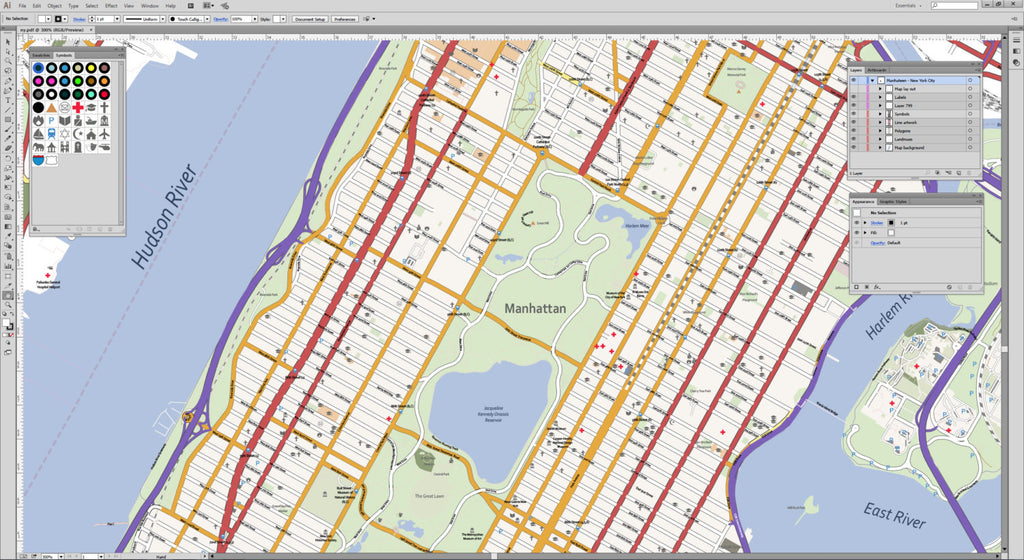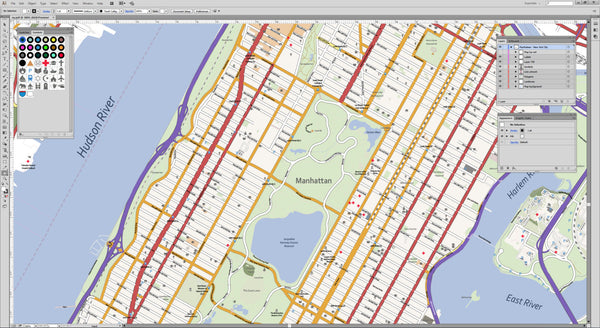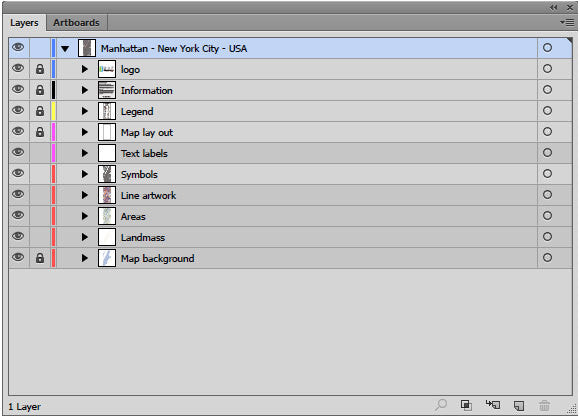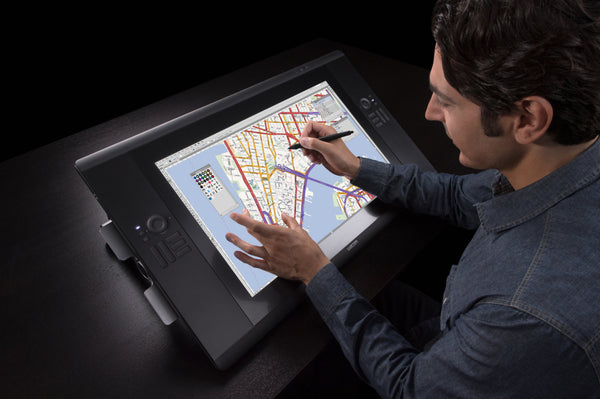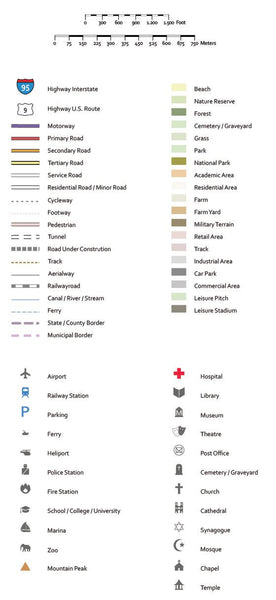Map Illustrators
Detailed Vector Map of Manhattan New York City
We just finished the design of one of the most detailed maps of Manhattan, New York, USA. Due to our map design process where we use local sources and high-resolution satellite images we are able to create city maps including the latest changes at street level.
Manhattan New York City Map (Нью-Йорк, 纽约市, 紐約市)
Save days of work and so thousands of dollars using our detailed Manhattan City Map in your design. Your topographic plan at street level contains editable layers for each cartographic category like roads, buildings, rivers, points of interests et cetera. This New York City Vector Map includes not only the city centre but the Manhattan neighbourhoods as well. This is what makes Map Illustrators stand out from other suppliers. Please contact us if you need a custom made vector city map of New York.
Benefits
- Save money: save tremendous time and money designing or printing your own city map
- No surprises: up-to-date 2022, complete and high-resolution cartography
- High quality: scale, crop or zoom to virtually any size without loss in detail or quality
- Copyright free: buy once, use as much as possible
- No risk: 30 days money back guarantee, no questions, no hassle
New York City facts
New York City (also referred to as "New York", "NYC", "The Big Apple", or just "the City" by locals), is the most populous city in the United States. It lies at the mouth of the Hudson River in the southernmost part of the state, which is part of the Mid-Atlantic region of the U.S. The city spans a land area of 305 square miles (790 km2). New York City has a population of approximately 8.2 million people. The New York Metropolitan Area, which spans lower New York, northern New Jersey, and southwestern Connecticut, has a population of 18.7 million, making it the largest metropolitan area in the U.S. As of 2007, it was 5th in the world, after Tokyo, São Paulo, Mexico City and Seoul.
New York City is a centre for media, culture, food, fashion, art, research, finance, and trade. It has one of the largest and most famous skylines on earth, dominated by the iconic Empire State Building. New York City is the business and financial capital of the world, and many leading national and international corporations have their headquarters there. The city's financial centre, Wall Street, is the world's leading centre of finance and the home of the nation's most important securities market, the New York Stock Exchange. The same area contains the nation's second largest exchange, the American Stock Exchange, and several smaller exchanges, including the Commodity Exchange, which deals in metals, rubber, and hides; the Coffee, Sugar, and Cocoa Exchange; the Cotton Exchange; the Futures Exchange; the New York Mercantile Exchange; and the International Monetary Market.
In addition, in the vicinity of Wall Street are many of the nation's biggest banks, trust companies, insurance companies, and brokerage houses. Because of its favourable location, excellent port facilities, and large population, New York City is the leading wholesale and retail trade centre in the United States. New York is also a leader in communications, the hotel and restaurant business, building construction, and manufacturing. New York City has reinvented itself economically in the last half of the 20th century. In 1945 it was the busiest port and the most important manufacturing centre in the world. Since that time, it has lost more than 800,000 of its 1 million factory jobs. Although more than 100,000 longshoremen once worked its docks, fewer than 10,000 did so in the late 1990s. Activity on the waterfront was decimated by a combination of intense competition from other U.S. ports and technological changes such as containerization, which allow ships to be loaded and unloaded by far fewer workers.
Between 1955 and 1980, the city also lost jobs as corporations left the city, moving to nearby suburbs or to other parts of the country. Companies found that they could cut the cost of office rentals, wages, and taxes that they had paid in the city. Since 1980, however, New York has experienced an economic boom, particularly in new service industries that provide services to individuals and businesses in such fields as finance and banking, health services, education, restaurants, and sales. It has also solidified its reputation as a financial, cultural, and communications centre. New York City’s banks and law firms have prospered.
The metropolitan region’s well-paid managerial class has worked to integrate the world economy with that of the United States, through the influence of the city’s stock market, investment banks, and currency traders. New York’s stock market, the largest in the world, has a profound influence on finances around the world. In addition, the city’s investment banks are extremely influential in establishing the value of foreign firms and currencies. By the end of the 1990s, every important financial institution in the world had a presence in New York, and Wall Street had become synonymous with high finance. Manhattan is the headquarters of the nation’s television and radio networks, making it the heart of the mass media in the United States. The headquarters of most of the nation’s major publishing houses and advertising agencies are also clustered in Manhattan’s Midtown.
Manhattan Neighborhoods
Manhattan's many neighbourhoods are not named according to any particular convention. Some are geographical (the Upper East Side), or ethnically descriptive (Little Italy). Others are acronyms, such as TriBeCa (for "TRIangle BElow CAnal Street") or SoHo ("SOuth of HOuston"), or the far more recent vintages NoLIta ("NOrth of Little ITAly") and NoMad ("NOrth of MADison Square Park").Harlem is a name from the Dutch colonial era after Haarlem, a city in the Netherlands.Alphabet City comprises Avenues A, B, C, and D, to which its name refers. Some have simple folkloric names, such as Hell's Kitchen, alongside their more official but lesser used title (in this case, Clinton).
Some neighbourhoods, such as SoHo, are commercial and known for upscale shopping. Others, such as Greenwich Village, the Lower East Side, Alphabet City and the East Village, have long been associated with the Bohemian subculture.Chelsea is a neighbourhood with a large gay population, and recently a centre of New York's art industry and nightlife.[119] Washington Heights is a vibrant neighbourhood of immigrants from the Dominican Republic. Chinatown has a dense population of people of Chinese descent.Koreatown is roughly bounded by 5th and 6th Avenues, between 31st and 36th Streets. Rose Hill features a growing number of Indian restaurants and spice shops along a stretch of Lexington Avenue between 25th and 30th Streets which has become known as Curry Hill.
In Manhattan, uptown means north (more precisely north-northeast, which is the direction the island and its street grid system is oriented) and downtown means south (south-southwest).This usage differs from that of most American cities, where downtown refers to the central business district. Manhattan has two central business districts, the Financial District at the southern tip of the island, and Midtown Manhattan. The term uptown also refers to the northern part of Manhattan above 72nd Street and downtown to the southern portion below 14th Street, with Midtown covering the area in between, though definitions can be rather fluid depending on the situation.
Fifth Avenue roughly bisects Manhattan Island and acts as the demarcation line for east/west designations (e.g., East 27th Street, West 42nd Street); street addresses start at Fifth Avenue and increase heading away from Fifth Avenue, at a rate of 100 per block on most streets. South of Waverly Place, Fifth Avenue terminates and Broadway becomes the east/west demarcation line. Though the grid does start with 1st Street, just north of Houston Street (the southernmost street divided in west and east portions; pronounced HOW-stin), the grid does not fully take hold until north of 14th Street, where nearly all east-west streets are numerically identified, which increase from south to north to 220th Street, the highest numbered street on the island. Streets in Midtown are usually one way with a few exceptions (14th, 23rd, 34th, and 42nd for example). The rule of thumb is that odd-numbered streets run west, while even-numbered streets run east.

